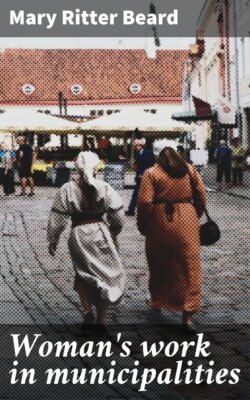Читать книгу Woman's work in municipalities - Mary Ritter Beard - Страница 8
The Visiting Teacher
ОглавлениеKnowing the vital connection between home life and the proper growth of children in the schools, women interested in educational matters have, within recent years, given great attention to visiting the homes of pupils. The development of the function of the “visiting teacher” is the result of a recognition that the school cannot thrive if it is indifferent to the home surroundings of children.
The visiting teacher is akin to the school nurse, and yet distinct in function. This new office is one of the latest creations in educational experimentation, though not based on novel ideas of education, since the sympathetic teacher has always sought to go beyond her pupils to outside influences that retarded or encouraged development. The visiting teacher comes as an aid to the regular teacher solely for educational purposes. Like the school nurse she makes the child the pivotal point on which she focuses her own experience and training. Like the nurse she may recommend that a child be placed under the care of a psychologist, a physician, a more expert teacher, a kindergartner, or that a social agency be called upon to assist in improving the sanitary, health, or financial features of the home environment. Her point of view, however, is ultimately increased intelligence, whereas the school nurse’s primary aim is health. While the functions of these two public servants are distinct, therefore, there is very often need of perfect coöperation, for health may underlie education in some cases and, in others, poverty may underlie both health and education.
In her report on Visiting Teachers for the Public Education Association of New York, Mary Flexner records the very high ratio of 45 per cent. of the cases covered by visiting nurses for the year 1911–1912 as being “cases” because home poverty retarded the development of the child. In explanation of the term poverty, Miss Flexner says: “This term is interpreted broadly to include all cases in which ‘economic pressure’ makes of the child an illegal wage-earner or a household drudge and forces the family to adopt such a low standard of living that there is neither proper space for the child to study nor proper food to give it the stimulus to do so.” Miss Flexner further shows that 57 per cent. of the cases showed lack of family appreciation of what are the needs of a normal or an abnormal growing child. A summary of the action taken in all the cases is a most vital part of the report.
The work of the visiting teacher began in New York City in 1906 when two settlements managed by women, Hartley House and Greenwich House, placed two visiting teachers in the field. Richmond Hill House and the College Settlement, where women also are the headworkers, were at the same time coöperating with this committee. The Public Education Association became interested at once and added to the number of such teachers. Other agencies soon began to join in the support of these teachers until, in 1913 after three years’ effort, two visiting teachers were placed upon the city’s payroll for ungraded classes.
The Home and School Peace League of Philadelphia has aroused interest in visiting teachers in that city until several are now supported privately for this work and are used to a considerable extent by the Bureau of Compulsory Education to carry out the preventive work in its charge.
In Boston also there are several privately supported social workers of this character, chiefly working for women’s organizations like the Women’s Educational Association, the Home and School Association, and some settlements. Such visitors are connected with a particular school or district and work there only. Worcester, Massachusetts, and Rochester, New York, also carry on some of this work to help the over-burdened teacher get better results in school.
Eleanor H. Johnson of the Public Education Association of New York, writing in The Survey on “Social Service and the Public Schools,” demonstrates the usefulness of the visiting teacher if further evidence were necessary. One of the visitors herself in her report to her Boston supervisors says: “This new work of visiting the homes of the school children is one of continual coöperation with principals, teachers, truant officers, janitors and the children themselves, also with hospitals, dispensaries, employment agencies, the Associated Charities, or whatever the emergency may demand. Too often this sort of effort is scattered and ineffective because of the lack of connection between agencies. With a visitor working from the school as a starting-point and not from any private organization, the connection is quickly made and the influence of each helping agency is strengthened by the added influence of every other. This has proved to be just as true in the case of medical social service, particularly that of public hospitals and institutions, and one might almost prophesy that some day the relief work of philanthropic agencies will come only in response to calls from the social service departments of church, hospital, public institution and school, and that a great clearing house for these agencies, public and private, will be the best way of organizing charity.”
There is great need of the extension of this work. The regular teachers do not have the time and strength to do the visiting that is requisite for successful teaching. Women understand women well enough to know that. They understand teaching of little folks well enough to know that, to keep fit for the classroom, the teacher must have her play time too; and the whole visiting teacher movement which women are fostering is based on their appreciation of the significance of the regular teacher and their realization of the need of her 100 per cent. efficiency for the sake of the child, for the sake of the teacher, for the sake of the taxpayer even, and for the sake of the future.
